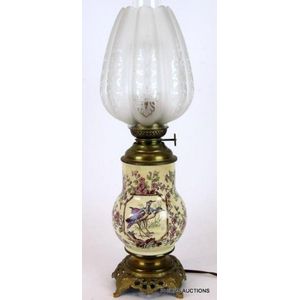An Electrified ceramic kerosene lamp, late 19th century the…
An Electrified ceramic kerosene lamp, late 19th century the faience base with a Japanesque transfer scene of storks and trees in bloom, with cast bronze mounts, glass chimney and a frosted glass etched shade in the form of a tulip, wired for electricity. Height 51 cm
You must be a subscriber, and be logged in to view price and dealer details.
Subscribe Now to view actual auction price for this item
When you subscribe, you have the option of setting the currency in which to display prices to $Au, $US, $NZ or Stg.
This item has been sold, and the description, image and price are for reference purposes only.
- Bronze - An alloy of copper and tin, traditionally in the proportions of about 9 parts of copper to 1 part of tin.
The discovery of bronze in Western Asia in the 4th century enabled people to create metal objects which were superior to those previoulsy possible because of its strength and hardness, and it has been used throughout the world for weapons, coins, tools, statuary and other decorative items.
It is very fluid in a molten state, and its hardness, strength when set, and non-corrosive properties makes it most suitable for casting sculpture. - Japanesque - Japanesque decoration refers to a style of art and design that incorporates Japanese motifs and elements into decorative objects, furniture, and architecture. This style emerged in the late 19th century and was popularized in the early 20th century as Western countries began to trade with and learn more about Japanese culture.
It is characterised by its use of traditional Japanese elements such as bamboo, cherry blossoms, koi fish, and landscapes. It often features a minimalistic and refined aesthetic, with clean lines and simple forms. Some common materials used in Japanesque decoration include wood, bamboo, lacquer, and ceramics.
Japanesque decoration had a significant influence on Western art and design, particularly in the Art Nouveau and Arts and Crafts movements. It also played a role in the development of Japonism, a movement in Western art and design that was inspired by Japanese art and culture. Today, Japanesque decoration continues to be used in a variety of contexts, from interior design and architecture to fashion and graphic design.
This item has been included into following indexes:
- kerosene / oil lamps, material
